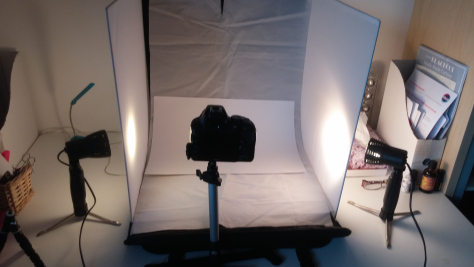Macro photography of scale models
Lighting
Sun
Taking photos under natural light is one option; however you will need to wait for the perfect conditions (slightly overcast sky, soft lights) which is not always an option. You should avoid direct sunshine: it makes the contrast really high between shadows and light areas. (Unless you are photographing spacecraft where a stark contrast is actually quite realistic.) The best times are usually early afternoon, with the sun covered by a reasonably thin cloud cover which diffuses its light.
Artificial light sources
The bare minimum should be two light sources for illumination. The white sides of the box diffuse the lights a bit, making the illumination less harsh, softening the shadows. (If you can install it, a third, overhead light source would not be a bad idea, either.) You don’t actually need a box; if you fabricate a diffuser you can put in front of your light sources, it works fine as well.
The easiest artificial lighting source is a lamp. Or more, to be exact, as you need more than one light source to avoid deep shadows and uneven lightning. Normal desk-lights are good enough (if you set the white balance of your camera -see below), but the best option is to use bulbs that mimic the sun’s light (sunlight/natural light bulbs). The setup should be something similar that is used in studios; at least two lights (a so-called “main” and a “fill”), 45 degrees from the subject.
Flashguns
Most cameras have built-in flashes but these are absolutely useless when it comes to macro photography; they are simply too far from the object, and they are not designed with macro photography in mind. (The camera/lens itself casts a shadow on the object, for one. They also are too strong for close-up work.)
An option is to use flashguns separated from your camera (we’re talking about expensive DSLRs with multiple expensive flashguns) similarly set up as the LED lights on the above photo; keep in mind that you definitely will need to use diffusers with them. This solution is not very economical as proper flashguns can cost £100 minimum (each), and you’d need at least two of these. (And they need to be remotely triggered, so you need the shoes holding the flashguns, and a remote control, too.) Here’s a pretty good article on studio photography; it applies to scale models as well. (I guess a model is a model…) The flashguns are set up similarly to the lamps we discussed before - for obvious reasons.
If you do a lot of macro photography, you can get a ring-flash that goes around the objective, providing appropriate lighting for the objects photographed, but these things are costly. I mean really costly. There is a cheaper alternative with LED lights -these are not flashguns, but they do provide extra light for your photographs, so they might be a viable option. One good thing they have going for them is that you can see your subject much better, so focusing is easier, since the LEDs are on all the time. They do eat up batteries, though. If you choose to buy one of these units, they will come very handy if you decide to go outside and start photographing insects and other small critters.
A tripod is also a useful thing (and again, an expensive one if you want something that is stable); and if you really want to go all-out a macro focusing rail also comes handy; but with a decent camera set up properly, and some proper light sources, you should be doing fine. It really is just a matter of practice from now on (and time you’re willing to spend with photographing).
I hope this article helped to start with macro photography; I do believe it’s one of the most interesting aspects of photography, so I encourage anyone to experiment with it.
Copyright ©2021 by Andras. Images and/or videos also by copyright holder unless otherwise noted. The views and opinions expressed herein are solely the views and opinions of the authors and/or contributors to this Web site and do not necessarily represent the views and/or opinions of Armorama, KitMaker Network, or Silver Star Enterrpises. All rights reserved. Originally published on: 2018-03-15 18:23:51. Unique Reads: 30674









